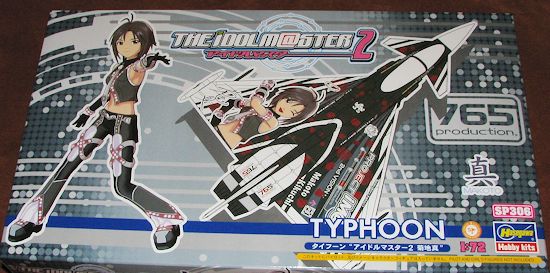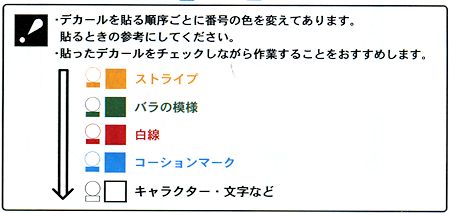
Hasegawa 1/72 Typhoon 'Idolmaster 2'
| KIT #: | 52106 |
| PRICE: | 3840 yen (about $40.00) on discount from HLJ |
| DECALS: | One option |
| REVIEWER: | Scott Van Aken |
| NOTES: | Special boxing |

| HISTORY |
The Eurofighter Typhoon is a twin-engine, canard-delta wing, multirole fighter. The Typhoon was designed and is manufactured by a consortium of consisting of three companies; EADS, Alenia Aeronautica and BAE Systems, who conduct the majority of affairs dealing with the project through a joint holding company, Eurofighter GmbH, which was formed in 1986. The project is managed by the NATO Eurofighter and Tornado Management Agency, which also acts as the prime customer.
Development of the aircraft effectively began in 1983 with the Future European Fighter Aircraft programme, a multinational collaborative effort between Germany, France, UK, Italy and Spain. Due to disagreements over design authority and operational requirements, France left the consortium to independently develop the Dassault Rafale instead. A technology demonstration aircraft, the British Aerospace EAP, first took flight on 6 August 1986; the first prototype of the finalised Eurofighter made its first flight on 27 March 1994. The name of the aircraft, Typhoon, was formally adopted in September 1998; the first production contracts were signed that same year.
Political issues in the partner nations significantly protracted the Typhoon's development; the sudden end of the Cold War reduced European demand for fighter aircraft, and there was debate over the cost and work share of the Eurofighter. The Typhoon was introduced into operational service in 2003. Currently, the type has entered service with the Austrian Air Force, the Italian Air Force, the German Air Force, the Royal Air Force, the Spanish Air Force, and the Royal Saudi Air Force. The Royal Air Force of Oman has also been confirmed as an export customer, bringing the procurement total to 571 aircraft as of 2013.
The Eurofighter Typhoon is a highly agile aircraft, designed to be an effective dogfighter when in combat with other aircraft; later production aircraft have been increasingly more well-equipped to undertake air-to-surface strike missions and to be compatible with an increasing number of different armaments and equipment. The Typhoon saw its combat debut during the 2011 military intervention in Libya with the Royal Air Force and the Italian Air Force, performing reconnaissance and ground strike missions in the theatre. The type has also taken primary responsibility for air defense duties for the majority of customer nations.
The Idolmaster 2 (アイドルマスター ツー Aidorumasutā Tsū , officially Romanized as THE iDOLM@STER 2) is a console raising simulation game released exclusively in Japan by Namco Bandai Games on February 24, 2011. The game is a sequel to The Idolmaster, and follows the career of a producer who works for the fictional integrated 765 Production and 961 Production idol agencies and has to work with a selection of thirteen pop idols. The game was released for the PlayStation 3 on October 27, 2011. It has been adapted into an anime television series and it will be adapted into an anime film.
| THE KIT |
 Hasegawa
is one of several companies to do a Typhoon and since it was, I believe, the
most recent one to reach the market, one would assume it is the most accurate.
Hasegawa
is one of several companies to do a Typhoon and since it was, I believe, the
most recent one to reach the market, one would assume it is the most accurate.
The kit is well detailed to Hasegawa's usual standards. The cockpit consists of a tub with control stick, throttle lever, five piece bang seat and a nicely done instrument panel. Decals are used for instruments. The forward canards are held in place by pins and can be moved. The kit will require nose weight and while the amount is not provided, there is plenty of space for it. The rather complex intake structure is nicely represented. Both full open and full closed burner cans are also provided. I wonder if, like the F-14, one is normally open and one normally closed on the ground.
In order to also do the two seater, there is a separate upper fuselage spine that incorporates the speed brake. This can be displayed open if one so wishes. The landing gear is well done and Hasegawa provides the option of closed gear for an in-flight model, though one will need to find a pilot figure. An optional extended or closed in flight refueling probe is also provided, which is a nice touch. The canopy can be displayed open or closed as well.
There are a bevy of things to put under the wings. One will need to open holes for the various pylons, of course. You have weapons here that I've never heard of including Taurus and Storm Shadow, which are quite large. AMRAAMs are provided as ar a pair of 1000 litre fuel tanks. You also have Meteor missiles, AIM-9Ls, IRIS-T and ASRAAMs. Of course, you cannot install all of these at the same time so you are provided with several diagrams showing what can go where. The end result will be a pretty heavily loaded aircraft.

Now to the main reason for the kit and that is the decal
sheet. This thing is huge and fills the bottom of the box. I had to take two
scans of it and join them as it is larger than the platen on my scanner. It is
one of the 13 idols in the series of Idolmaster 2 as you might guess from the
box art. From the look of it, there is very little of the aircraft that is
actually covered in paint; that part being a mix of Gunze 71 and 34 to match the
 darker
decals. There is a definite sequence to applying the decals and these are all
color coded in the three page full color placement guide. Though I can't read
it, I've included what looks like this sequence in hopes that a reader can help
out. Reader Phil Laskey has told me these read as "Stripes, Roses, white outlines, caution mark, character. Hasegawa decals are currently quite good and while not as opaque as most
would want, should prove to not be an issue if carefully applied. I have to
confess that one of my worst decaling nightmares was with a large Hasegawa
airliner marking that did everything wrong that a large decal can do! At least
with this one I have the option of standard aftermarket schemes. I should
mention as well that the instructions, in addition to being completely in
Japanese are also in a different format from what I'm used to seeing in Hasegawa
instructions. Not better or worse, just different.
darker
decals. There is a definite sequence to applying the decals and these are all
color coded in the three page full color placement guide. Though I can't read
it, I've included what looks like this sequence in hopes that a reader can help
out. Reader Phil Laskey has told me these read as "Stripes, Roses, white outlines, caution mark, character. Hasegawa decals are currently quite good and while not as opaque as most
would want, should prove to not be an issue if carefully applied. I have to
confess that one of my worst decaling nightmares was with a large Hasegawa
airliner marking that did everything wrong that a large decal can do! At least
with this one I have the option of standard aftermarket schemes. I should
mention as well that the instructions, in addition to being completely in
Japanese are also in a different format from what I'm used to seeing in Hasegawa
instructions. Not better or worse, just different.
| CONCLUSIONS |
Apparently kits like this have quite an appeal in Japan or Hasegawa would not pay for the rights to them and they do seem to sell well in Japan. Not sure how well they do elsewhere, but they are definitely something different.
| REFERENCES |
http://en.wikipedia.org/wiki/Eurofighter_Typhoon
http://en.wikipedia.org/wiki/The_Idolmaster_2
June 2013
Thanks to Hobby Link Japan for the preview kit. You can find this kit at
this link.
If you would like your product reviewed fairly and fairly
quickly, please
contact
the editor or see other details in the
Note to
Contributors.